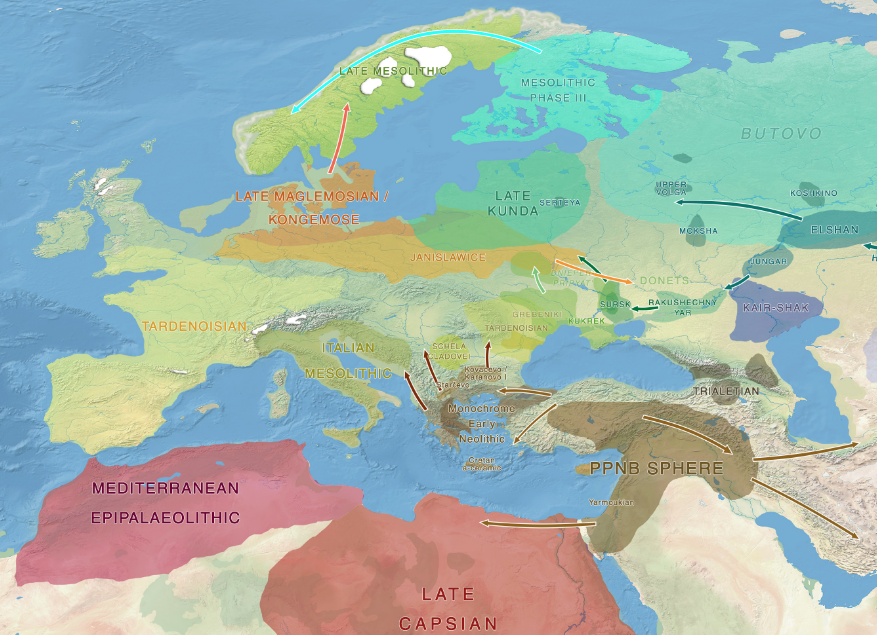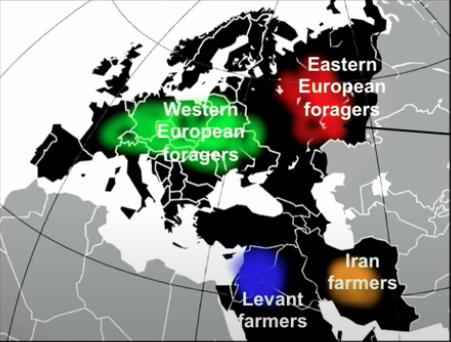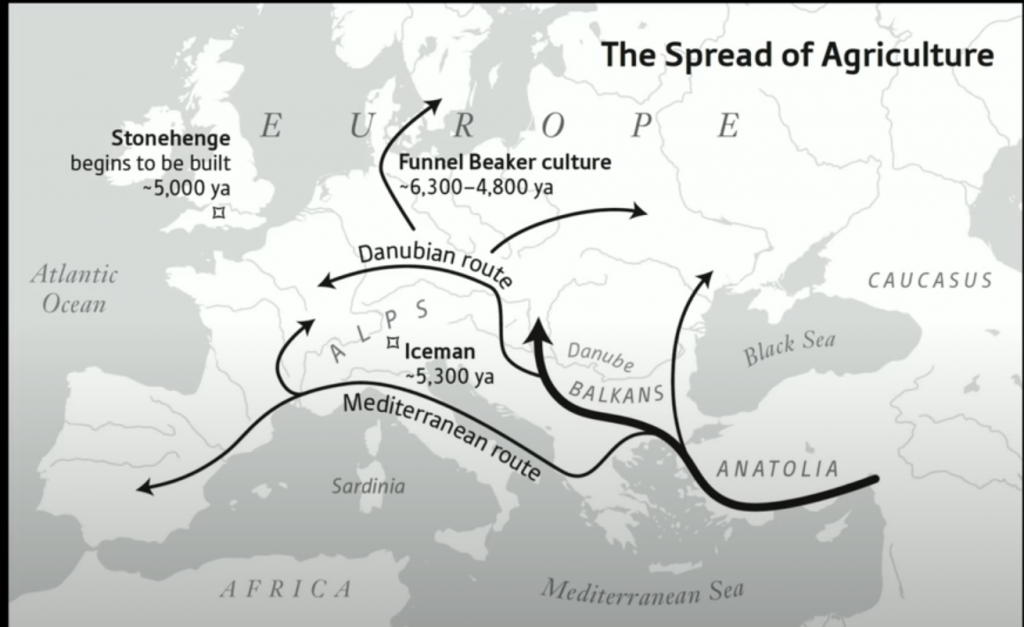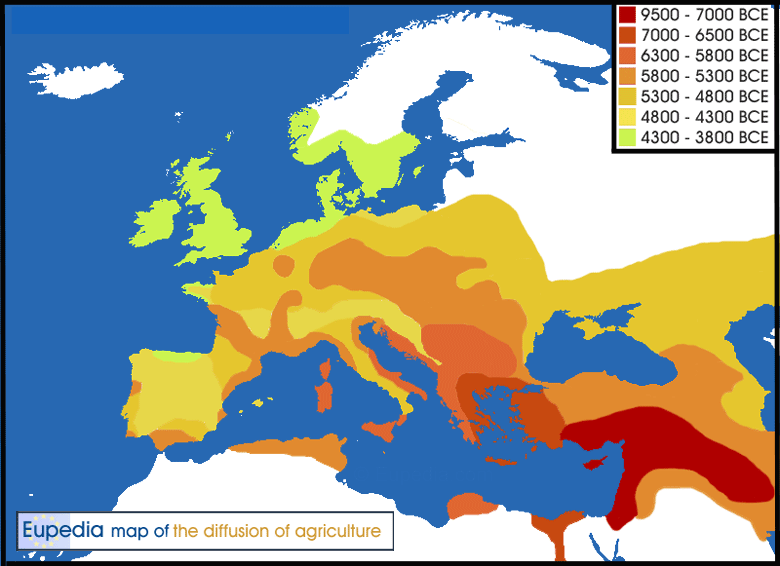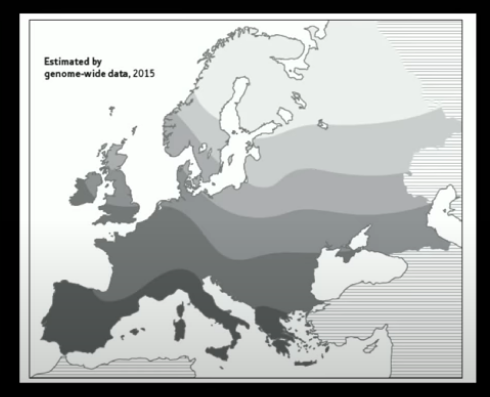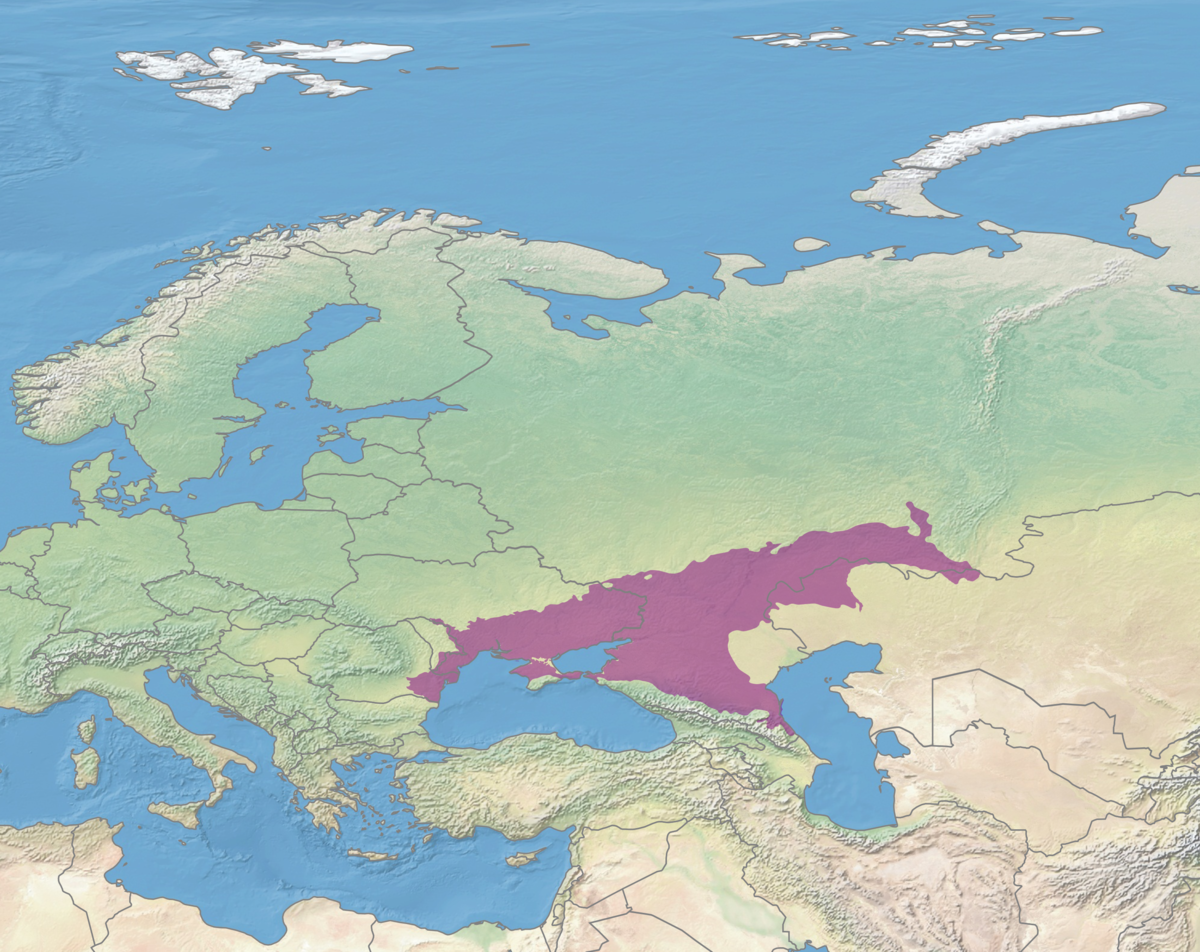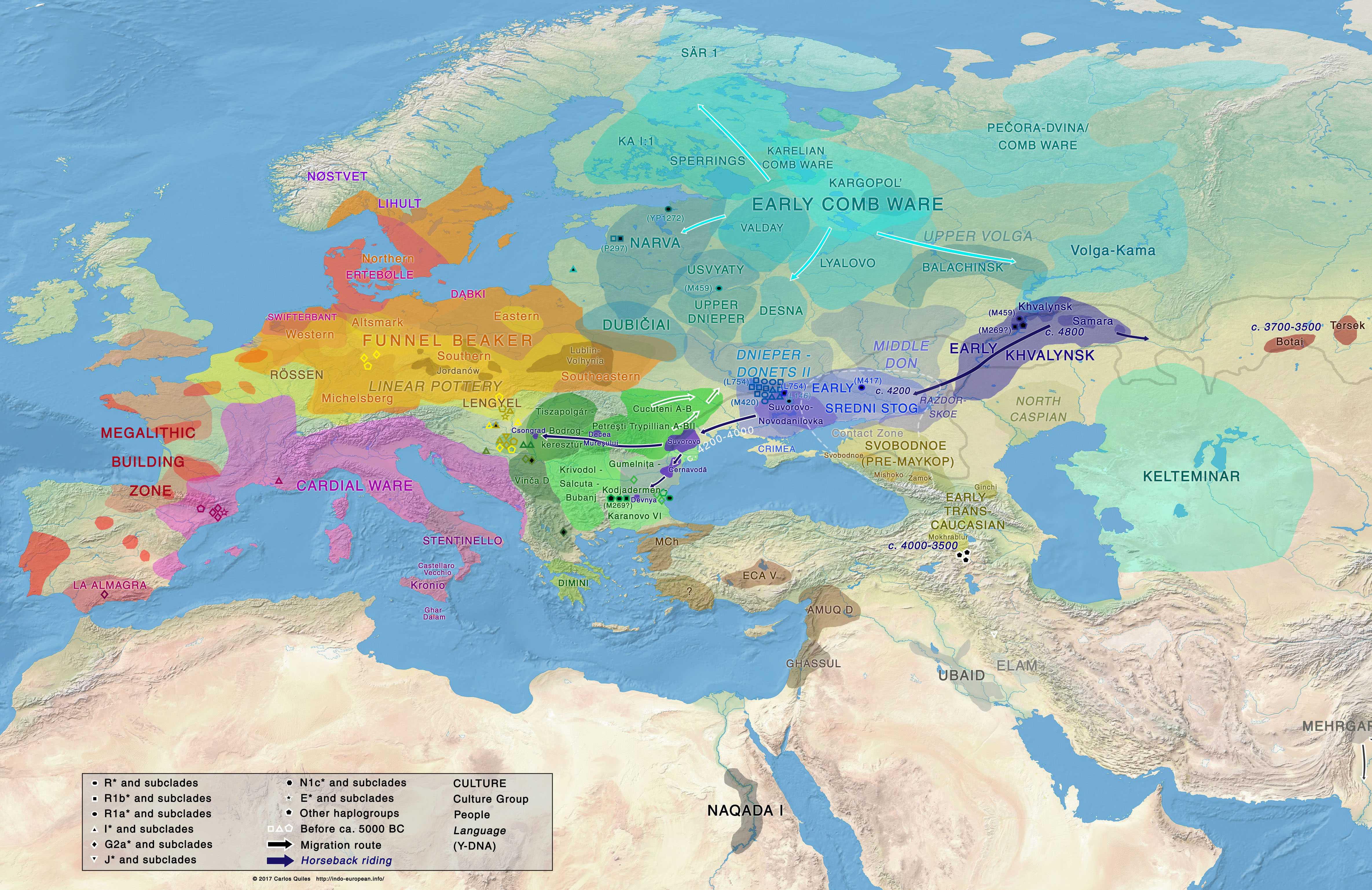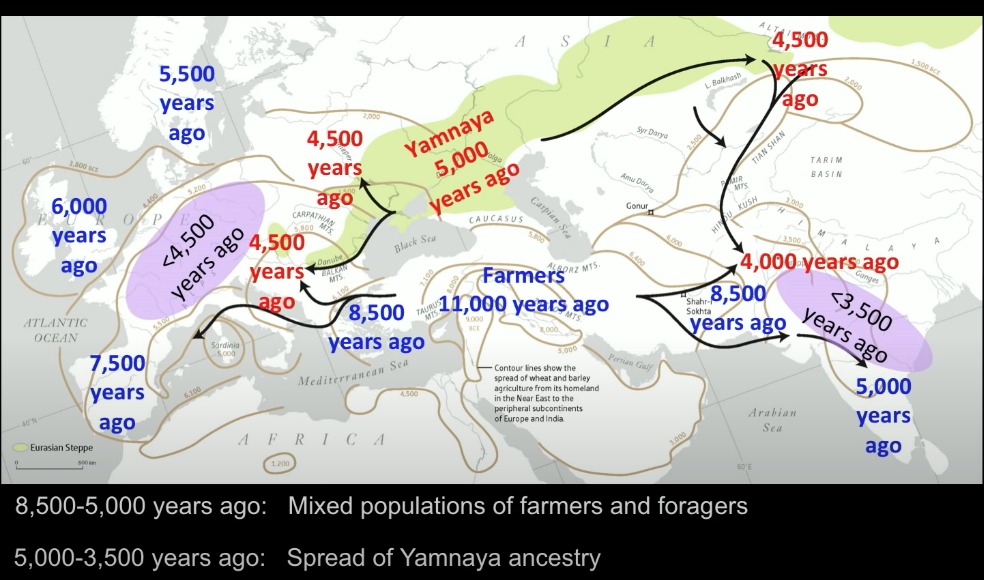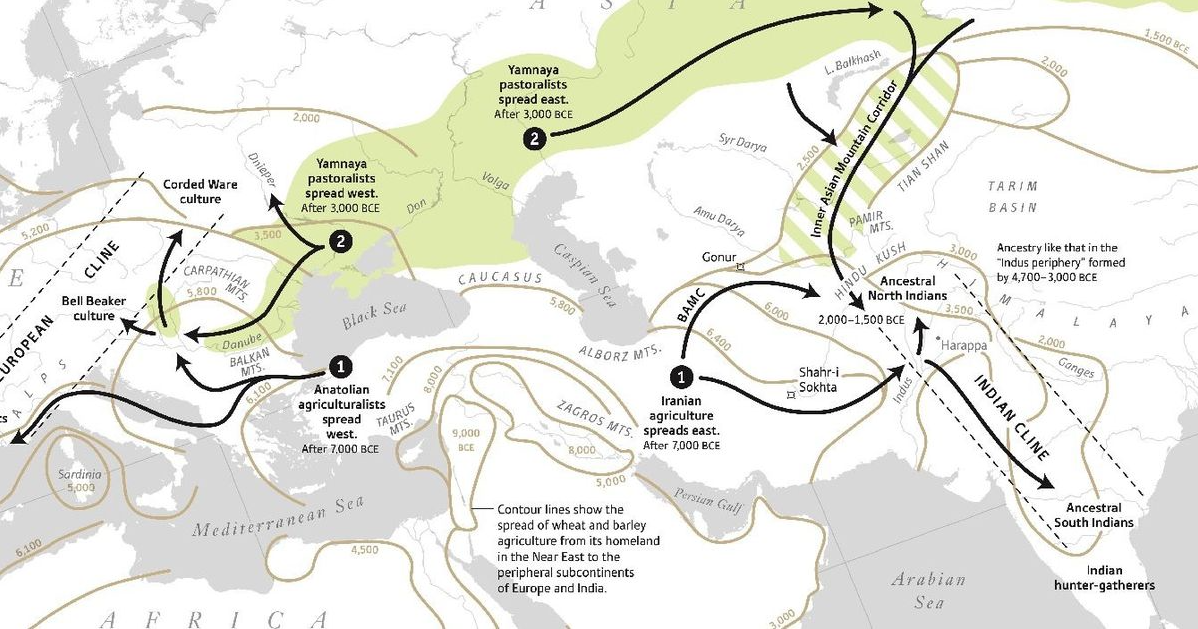The Mesolithic – The First Dark Age
(Human)
Paleolithic >
Mesolithic (“middle stone age”) (Europe 13,000 BC to 3,000 BC)
or Epipaleolithic (outside of europe) (18,000 BC to 6,000BC).
Generation Seven: Adapting to the Exhaustion of Megafauna, and a difficult time for humans.
Status: Climate Crisis: Out of Africa > Dependence on the Sea > Nomadic Hunting Megafauna Herds > Ice Age Retreat > Semi Sedentary Small Game and Fishing, dependent on rivers > Domestication of animals and plants > rise of settlements (cities) > bronze revolution and rule > rise of trade, states, and empires.
The Mesolithic refers to the final period of hunter-gatherer cultures in Europe and Western Asia, between the end of the Last Glacial Maximum and the Neolithic Revolution. The change in behavior occurred at different times in different regions, so the Mesolithic refers to different time spans in different parts of Eurasia, and the term is used less when referring to areas further east, and not at all beyond Eurasia and North Africa. China didn’t experience the same phase (decline), and similar time frames are considered Early Neolithic instead.
Transitional from hunter gatherers to sedentary if only seasonal.
Using many different resources (secondary food sources)
Increased use of boats and oars
Gradual semi-sedantism
Homes
Clearing of Forests
Selective Burnings
Small Dams and Ponds
Some Pottery
Traps, Nets
Bows and Arrows
Microliths mounted on a shaft to produce serrated edges.
Burials remain the same, cremation, inhumation, and remain personal, coated with red ochre.
Ranked society
Evidence of violence
Our Mesolithic Stage
The Mesolithic Dark Age
Overkill – the exhaustion of a food source – appears consistently on our journey through history, and the Mesolithic is one result. Seventy-five percent of the larger animals (those of more than 40 kilograms live weight) that became extinct during the late Pleistocene did so by about 10,800 to 10,000 years ago. Whether the primary cause of this decimation was climatic or cultural is still debated, the pattern of history in eurasia and the americas, and in the modern age, in the absence of an extinction level event – other than humans, is hard to blame on other than humans – even if other hypotheses for the late Pleistocene extinctions, such as those involving climatic changes or disease outbreaks, have emerged.
Northern European Continuity: In northern Europe, the hunter gatherers were able to live well on rich food supplies from the marshlands created by the warmer climate, limiting their need to adapt to changes in food supplies – and as a consequence they delayed the coming of (need for) the Neolithic (farming) until 3,500 BC. And the most interesting bit of evidence is the sophistication of their cooking recipes, which would make any contemporary chef proud.
Elsewhere, the pressure to innovate: Necessity is the mother of invention, or rather, scarcity provides incentive to innovate, so while soutwest asia (levant, Mesopotamia) exhausted local hunting, and had to resort to additional food sources, europe – with lower population density, better climate, better terrain, better rivers – could maintain a primarily meat diet much longer. The period saw such successful human predation of animals, and increase in population, that it caused a decline in the group-hunting of large animals in favour of a broader hunter-gatherer way of life, and the development of more sophisticated and typically smaller lithic tools and weapons than the heavy-chipped equivalents typical of the Paleolithic. Art declines. The sites are now mostly cliff faces in the open air, and the subjects are now mostly human rather than animal, with large groups of small figures; there are 45 figures at Roca dels Moros. Clothing is shown, and scenes of dancing, fighting, hunting and food-gathering. The figures are much smaller than the animals of Paleolithic art, and depicted much more schematically, though often in energetic poses. The more permanent settlements tend to be close to the sea or inland waters offering a good supply of food. Mesolithic societies are not seen as very complex, and burials are fairly simple; in contrast, grandiose burial mounds are a mark of the Neolithic.
Europe
There is little of interest to say about the european mesolithic other than the necessary improvement in the precision of stone tools for the shift to dependence upon fishing and hunting smaller game, rather than their ancestral emphasis on hunting of megafauna.
Western Europe: Tardennosian Culture: (Belgium, France, Britain, Spain, Central Europe. Questionable time span, poor documentation, and artifacts differ little from earlier cultures only by the presence of geometric microliths, microburin, scalene triangles, trapezoids and chisel-ended arrowheads and small flint blades made by the pressure-technique.
Northern Europe: Fosna, Hensbacka, and Komsa Cultures, Norway-Sweden (10,000/8300 BC to 7300 BC). On area, central Bohuslän, may well have had the largest seasonal population in northern Europe during the Late Palaeolithic/early Mesolithic transition. The settlements were located close to the contemporary seashore but, due to constant land uplift after deglaciation, they are now well above present-day sea level. Sites indicate fishing and seal hunting were important for the economy likely that hide covered wooden framed boats were used in because the majority of sites are located on islands in the outer archipelago. The culture relied purely on hunting and gathering, and archaeologists have only found stone tools, especially flake axes, lanceolates and tanged arrowheads. Again, these are less sophisticated tools than the preceeding era. The Komsa Culture was almost exclusively sea-oriented, living mainly off seal hunting, fishing, and boat-building, and their stone tools and other implements appear relatively crude.
Baltics: Swiderian-Kundra Culture (11,000 to 8,200 BC), Baltic Forest: Poland-Latvia-Estonia-Russia-Urals, (Soultrean> Swiderian > Kundra -> to Neolithic: Narva -> Pit Comb -> Corded Ware). Genetics were Western Hunter-Gatherers (WHGs) 70% Eastern Hunter-Gatherers (EHGs) 30%, with a substntial contribution of Ancient North Eurasians (ANE). ANE ancestry was lower than that of Scandinavian Hunter-Gatherers, indicating that ANE ancestry entered Scandinavia without traversing the Baltic.
Ahrensburg located to the northwest of Europe.
Asturian located Iberian Peninsula.
Italian Mesolithic
Old Europe – The Balkans
The relative climatic stability in the Balkans, compared to northern and western Europe, enabled continuous settlement. So the area may have effectively functioned as an ice-age refuge from which much of Europe, especially eastern Europe, was re-populated. And that begs the question whether or not there was a period which could be described as Mesolithic in southeastern Europe, rather than an extended Upper Palaeolithic or Epipalaeolithic Balkans, which might describe better its gradual changes and poorly defined development.
Balkans: “Iron Gates” Culture (11,000 BC to 3500 BC) Danube, Balkans, between Romania and Servia. (“Old Europe”). The archaeological complex that consists of one large settlement with around 10 satellite villages dated from 6300BC – 6000 BC, called Lepenski Vir, and due to its permanency, organisation, as well as the sophistication of its architecture and construction techniques may constitute the first “City” in europe. These people were most closely related to Western European hunter-gatherers, but with some additional contribution from Eastern European hunter-gatherers and Anatolian Neolithic farmers.
Skin Painting
War
Ceramics
The Sledge
Wood Canoes
Caucuses:
Trialetian Culture
South Asia
(Human)
Paleolithic >
Late Epipaleolithic (Southwest Asia) >
Natufian (“Settlements”) (12,000 to 9,500 BC or 13,050 to 7,550 BC). The Natufian culture is a Late Epipaleolithic or “proto-Neolithic” archaeological culture that existed in the Levant. The culture was unusual in that it supported a sedentary or semi-sedentary population even before the introduction of agriculture. They lived in small round houses, dug into the earth, with stone foundations, posts, brush roofs, and a central hearth. Settlements were semi-temporary and they moved often. The Natufian communities may be the ancestors of the builders of the first Neolithic settlements of the region, which may have been the earliest in the world. Natufians founded a settlement where Jericho is today, which may be the longest continuously inhabited urban area on Earth. Natufians were hunters and gatherers and gazelles were the main prey, but they also hunted deer, aurochs and wild boar in the steppe zone, as well as onagers an ibex. Water fowl and freshwater fish formed part of the diet in the Jordan River valley. And there is evidence of communal hunts with nets, And most interestingly, the wooded terrain was ideal for wild grains, and exploited wild cereals – and some evidence suggests the oldest known evidence of deliberate cultivation of cereals -specifically rye, bread-making, and beer.
The Holocene
(Climate)
Quaternary > Upper Pleistocine > Pleistocine End > The Holocene (“Entirely New”,”Civilizational Age”), (9,700 BC to Present) The Period of Post Glacial formation of fully modern humans and the post glacial evolution of agrarianism. It can be subdivided into five time intervals, or chronozones, based on climatic fluctuations:
Preboreal (8,000 BC – 7,000 BC),
Boreal (7,000 BC – 6,000 BC),
Atlantic (6,000 BC – 3,000 BC),
Subboreal 3,000 BC – .5 BC) and
Subatlantic (.5 BC – present).
The Holocene includes the period of: … Settlement
… Institutions (or Formal Institutions) (organization, strategy, resources, cultures)
… States (control, organization, strategy, resources, culture)
… Empires (civilizations, core states, core institutions)
… Civilizations (Balances of Power between civilizations.)
… Mass Extinctions
The present Interglacial (9700 BC to Present) The earth is currently in an interglacial (warm) period, and the last glacial period ended about 10,000 years ago. All that remains of the previous continental ice sheets are the Greenland and Antarctic ice sheets and a few minor glaciers.
The back breaking work of women under agrarianism, and the suppression of underclass reproduction of such women produced the predictable results.
The Neolithic – Agrarian Revolution – Resurrection
Generation Eight
[ THE THIRD GREAT LEAP FORWARD ]
[ HERE : 50-24000 years to create fully contemporary humans]
(Human)
Neolithic (“New Stone Age”) The Period of Settlement, Pottery, Agriculture, and polished stone tools.
… SW Asia: (10,200 BC to 4500 BC)
… Europe (to 1700 BC)
… China (to 1200 BC)
Other parts of the world (including Oceania and the northern regions of the Americas) remained broadly in the Neolithic stage of development until European contact
The Neolithic includes a progression of technological, behavioral, and cultural changes including the use of wild and domestic crops, domestication of animals, new clothing, building of shelters, sedentary living, social organization, and eventually, pottery, that evolved out of Natufian Culture.
As the Natufians became dependent on wild cereals in their diet, and developed a sedentary way of life, the climatic changes associated with the Younger Dryas (about 10,000 BC) forced people to develop farming. By 8,800 BC farming communities had arisen in the Levant and spread to Asia Minor, North Africa and North Mesopotamia.
Early Neolithic farming was limited to a narrow range of plants, both wild and domesticated, which included einkorn wheat, millet and spelt, and the keeping of dogs, sheep and goats. By about 6900–6400 BC, it included domesticated cattle and pigs, the establishment of permanently or seasonally inhabited settlements, circular and rectangular multi-room buildings, and the use of pottery.
The archaeological industry is overly interested in minor developments in different regions of the world, but for our purposes, the climate generated demand for farming, and population growth for settlements, a division of labor, and eventually expansion of settlements into new regions.
In other parts of the world, such as Africa, South Asia, Southeast Asia and East Asia, independent domestication events, and technological innovations led to regionally distinctive Neolithic combinations. Travel has always existed, trade has always existed, and information spreads quickly – but unevenly. But it’s this rapid spread of the technology around the world that we should take notice of.
Temple Religion Begins – With Hunter Gatherers
These Hunter Gatherers appear to have developed an animistic religion of some sort in Anatolia by 10,000 bc, with temple construction on a barren flat hilltop (plateau) with fifty miles of visibility in every direction in what is today an arid plain. In the neolithic, with the mountains catching the rain, a porous bedrock created many springs, creeks, and rivers, so this region in the upper reaches of the Euphrates and Tigris was a refuge of wildlife during the dry and cold Younger Dryas climatic event (10,800–9,500 BC). Archaeologists have discovered at least two of these temple complexes and general consensus is that there must be more.
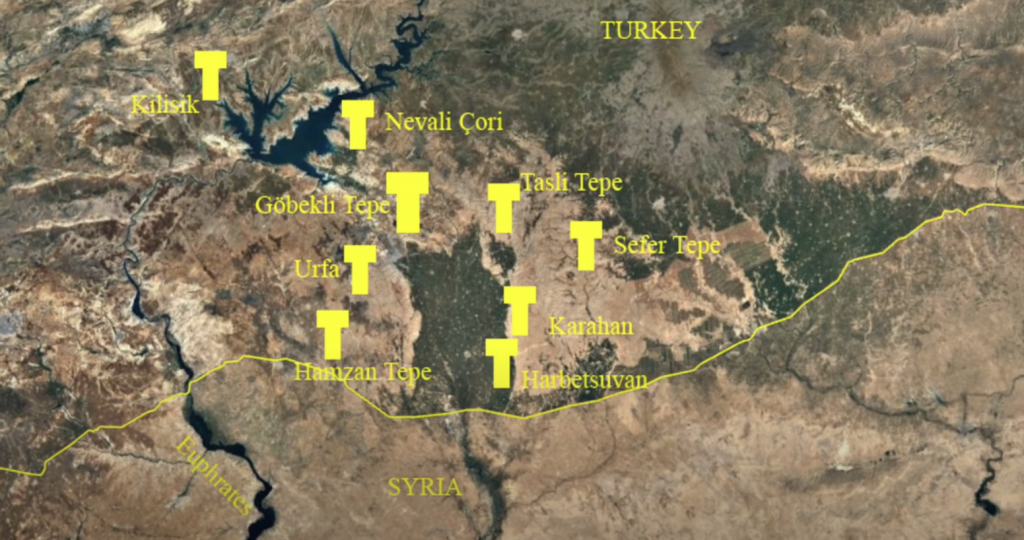
Present theory suggests its a mountain hunting retreat that took advantage of seasonal migration of gazelles that somehow evolved into a place of pilgrimage, rituals, feasts and celebration. And it appears from the genetic evidence that the original domestication of wheat occurred within twenty miles of the site.
Local population expansions locally may have led them to develop common rituals strengthened by monumental gathering places to reduce tensions and conflicts over resources, and probably, to mark territorial claims. The structure of the site we call Gobekli Tepe predates pottery, metallurgy, and the invention of writing or the wheel.
Consensus appears to be that this religion was likely shamanistic, and that gods did not develop until the later Mesopotamian period. This corresponds to an ancient Sumerian belief that agriculture, animal husbandry, and weaving were brought to humans from the sacred mountain which was inhabited by deities – very ancient deities without individual names. (A parallel to the Greek Mount Olympus.)
The animal and other images give no indication of organized violence. Meaning there are no depictions of hunting raids or wounded animals, and the carvings generally ignore game on which the society depended, such as deer, in favour of formidable creatures such as lions, snakes, spiders, and scorpions.
Around the beginning of the 8th millennium BCE Göbekli Tepe lost its relevance. The advent of agriculture and animal husbandry brought new realities to human life in the area, and the “Stone-age zoo” apparently lost whatever significance it had had for the region’s older, foraging communities. For reasons unknown, the site was deliberately buried under earth, saving it from man and the elements.
The Domestication of Animals (Pastoralism) and Plants (Agriculture) Begins
Humans began domesticating plants and animals where and when it was most necessary to domesticate them: where they had produced enough of a population to overtax the flora and fauna. Necessity was the mother of the invention.
Animals: Pigs were domesticated in Mesopotamia around 11,000 BC, followed by sheep between 11,000 BC and 9000 BC. Cattle were domesticated from the wild aurochs in the areas of modern Turkey and Pakistan around 8500 BC.
Crops: Starting from around 9500 BC, the eight Neolithic founder crops – emmer wheat, einkorn wheat, hulled barley, peas, lentils, bitter vetch, chick peas, and flax – were cultivated in the Levant. Rye may have been cultivated earlier, but this remains controversial. Rice was domesticated in China by 6200 BC with earliest known cultivation from 5700 BC, followed by mung, soy and azuki beans.
Sugarcane and some root vegetables were domesticated in New Guinea around 7000 BC. Sorghum was domesticated in the Sahel region of Africa by 3000 BC. In the Andes of South America, the potato was domesticated between 8000 BC and 5000 BC, along with beans, coca, llamas, alpacas, and guinea pigs. Bananas were cultivated and hybridized in the same period in Papua New Guinea. In Mesoamerica, wild teosinte was domesticated to maize by 4000 BC. Cotton was domesticated in Peru by 3600 BC. Camels were domesticated late, perhaps around 3000 BC.
For this change to occur across the planet, despite the distance between hunter gatherer populations, a change in climate had to create the opportunity and incentive.
Crisis: The Black Sea Deluge (Flood)
Whether causal or not, the Black Sea Deluge occurs sometime between 7000 and 5600 bc. This event probably accounts for the lack of neolithic sites in Northern Anatolia (Turkey) – they’re now underwater. There are at least three early human sites of freshwater development that have been inundated by the floods: the Persian gulf flood – most likely candidate for the first civilization, the Black Sea flood, and the Doggerland flood in what is today’s North Sea. (The flooding of the Mediterranean 5M years ago, is before modern humans.) Although the Missoula floods in North America likely (at least according to myth) at least affected the first Siberians migrating to the Americas.
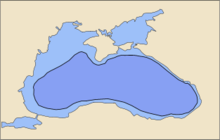 Theorized expansion of the Black Sea during the deluge. Note that all coastal communities would have been inundated and buried.
Theorized expansion of the Black Sea during the deluge. Note that all coastal communities would have been inundated and buried.
Continued Striation of Groups
Sometime around 43,000 BC, the ancestors of what would become the Early European Farmers (EEF) are believed to have split off from Western Hunter-Gatherers (WHGs), and again, these EEF appear to have split from Caucasian Hunter-Gatherers (CHGs) around 23,000 BC, Just as Ancestral North Eurasian (ANE) Hunter Gatherers split off from Western Hunter gatherers, around 24,000 BC.
Result:
North: Western Hunter Gatherers
Center: Caucuses and Anatolia: Caucasion Hunter Gatherers
South: the Levant: Early European Farmers
Adaptive Speciation Begins
43,000 BC, the ancestors of what would become the Early European Farmers (EEF) are believed to have split off from Western Hunter-Gatherers (WHGs), and again appear to have split from Caucasian Hunter-Gatherers (CHGs) around 23,000 BC. And Ancient North Eurasian Hunter Gatherers hybridized and split off from european hunter gatherers 24000BC.
So, at the beginning of the Neolithic there are at least four separate races as different then as europeans and asians are today.
South Asians (india), North and South (Asians Eas Asia), Siberians and Siberian Americans (north America), Oceanans, and Austronesians, are all equally
Early Neolithic Cultures in Europe
(6000 BC to 5000 BC)
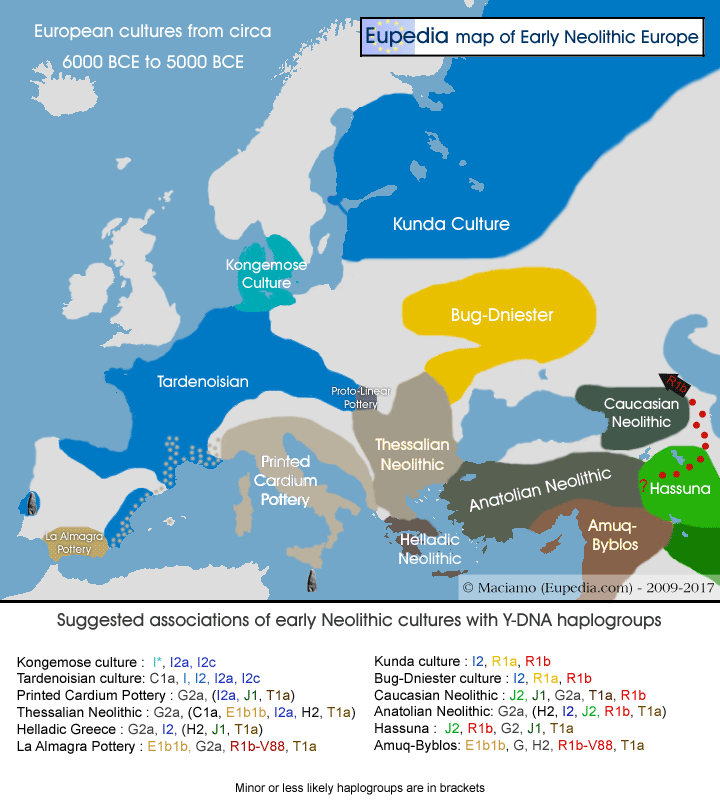
Farmers Spread into Eurasia: Agrarian Hybridization
The Farmer Migration (The descendants of the EEF and CHG migrated from Anatolia to the Balkans in large numbers – a single massive migration – during the 7th millennium BC, where they almost completely replaced the WHGs.
In the Balkans, the EEFs appear to have divided into two wings, who expanded further west into Europe along the Danube (Linear Pottery culture) or the western Mediterranean (Cardiol Ware). But large parts of Northern Europe and Eastern Europe remained unsettled by EEFs.
The Westward branch continued to expand along the Mediterranean coast, into the Iberian peninsula, up through France, and by 4000bc, into the British isles, and 3500bc into scandinavia.
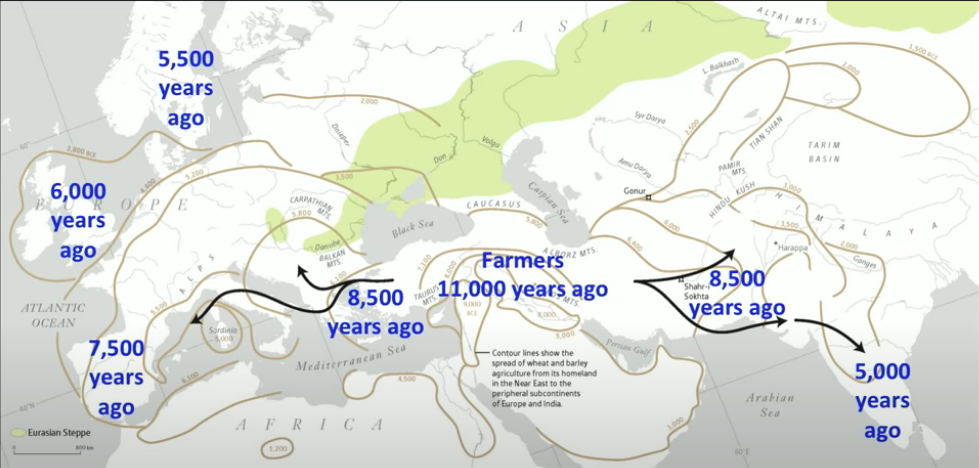 Spread and direction of agriculture. Note: convert these dates from YA to BC for consistency.
Spread and direction of agriculture. Note: convert these dates from YA to BC for consistency.
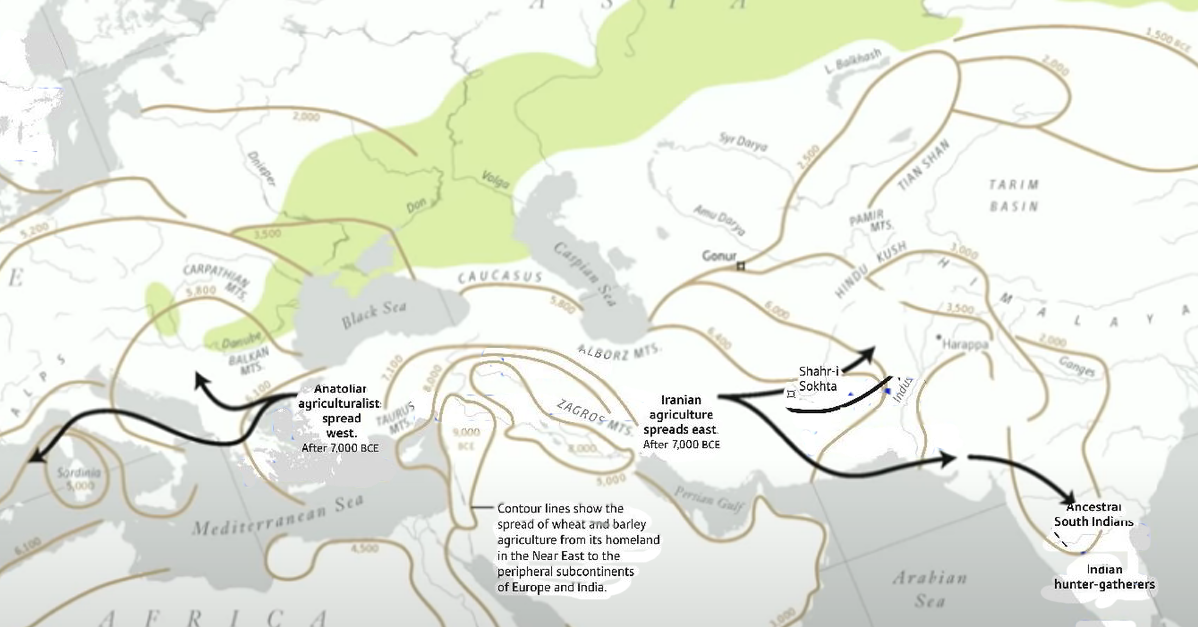
The EEFs spread agriculture throughout Europe largely without admixture with local WHGs. The EEFs subsequently split into two branches, one which spread northwards along the Danube through the Linear Pottery culture, and another which spread westward across the Mediterranean coast through the Cardinal Ware culture. By 5600 BC, these cultures had brought agriculture to Iberia and Central Europe.
The slight mixture between EEFs and hunter-gatherers in the Early Neolithic appeared to have happened without sex-bias, increases in hunter-gatherer ancestry appeared to be largely the result of males with hunter-gatherer ancestry mixing with females with EEF ancestry. Hunter-gatherer ancestry was even higher among Late Neolithic samples from the Cucuteni–Trypillia culture, Funnelbeaker culture and Globular Amphora culture, which carried about 75-80% EEF ancestry while being dominated by hunter-gatherer paternal lineages.
Initial westward spread of the EEFs from the Balkans was accompanied only by slight admixture with hunter-gatherer populations. Peoples of Middle Neolithic and Chalcolithic Iberia were found to carry about 75% EEF ancestry and 25% WHG ancestry, more WHG ancestry than Early Neolithic Iberians. Significant reductions in EEF ancestry during the later phases of the Neolithic was also observed in Central Europe, particularly in the northern and eastern parts of the region
In the southern Balkans, the Middle Neolithic farmers display reduced levels of EEF ancestry increased amounts of ancestry related to Caucasian Hunter-Gatherers (CHGs), suggesting further gene flow from Anatolia, which continued into the Bronze Age.
EEF ancestry remains throughout Europe, ranging from about 60% near the Mediterranean Sea (with a peak of 85% in the island of Sardinia) and diminishing northwards to about 30% around the Baltic Sea.
So, while the WHGs were largely displaced by successive expansions of Early European Farmers (EEFs) during the early Neolithic, they experienced a male-driven resurgence of WHG during the Middle Neolithic, for reasons we don’t yet understand – but could be as simple as recruitment.
Selection: The gene for light eye color was at 100% fixation in hunter-gatherers throughout western Europe. Northern (Scandinavia) had the gene for white skin. Spain and Luxembourg did not. European farmers had a mixture (homozygous).
Cultures of Neolithic Europe (5,000 BC to 4,500 BC)
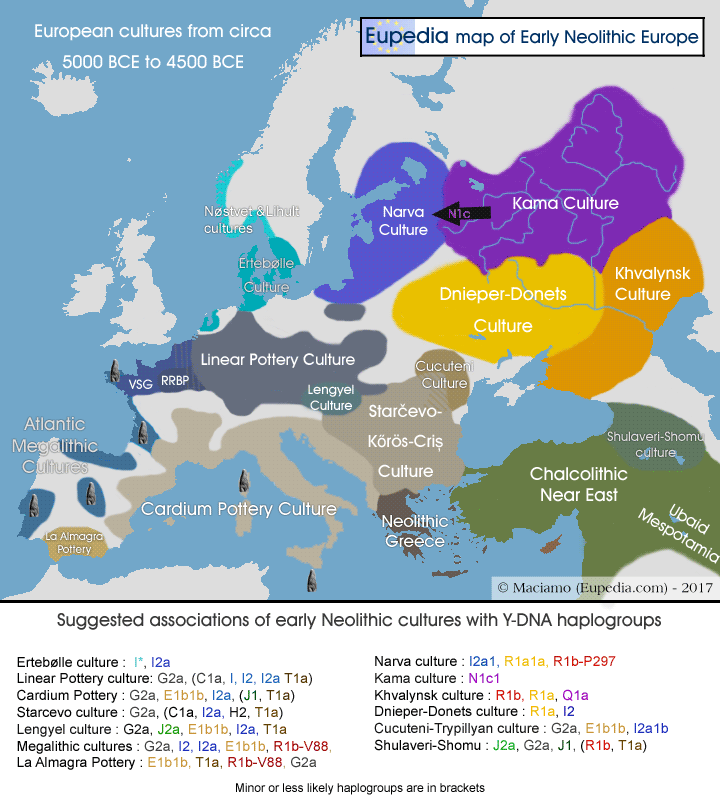
Pre-History
(Historical)
Pre-History (Pre-Writing) >
Protohistory (“Early Writing”): Period between prehistory and history, during which a culture or civilization has not yet developed writing but other cultures have already noted its existence in their own writings; the absolute time scale of “protohistory” varies widely depending on the region, from the late 4th millennium BCE in the Ancient Near East to the present in the case of uncontacted peoples.
The Age of Metal
(Human)
Neolithic >
Chalcolithic: (“Copper Age”) (4,500 BC to ???? ) The Period of Metallurgy.
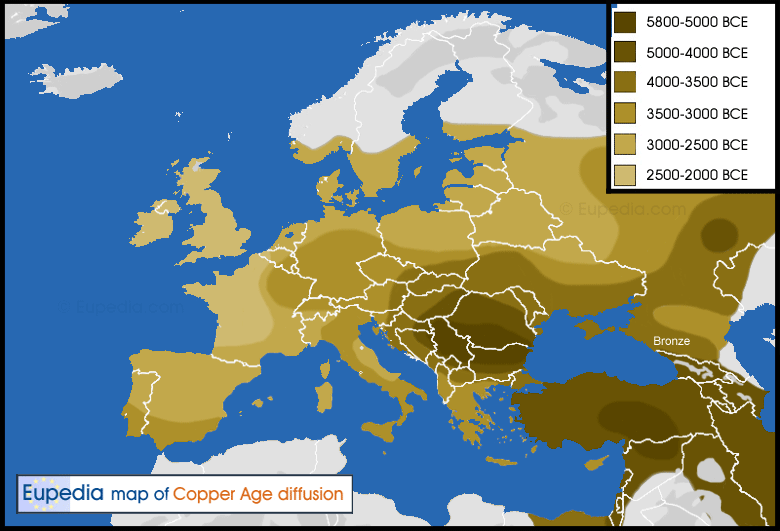
Indus Region (Proto Indus Valley Civilization)
Balochistan (6500 BC)
“Baloch” was the name by which the Indus Valley Civilisation is believed to have been known to the Sumerians (2900–2350 BC) and Akkadians (2334–2154 BC) in Mesopotamia. But it disappears from the Mesopotamian records at the beginning of the second millennium BC.
Mesopotamia
The Ubaid Period (6500 BC to 3800 BC)
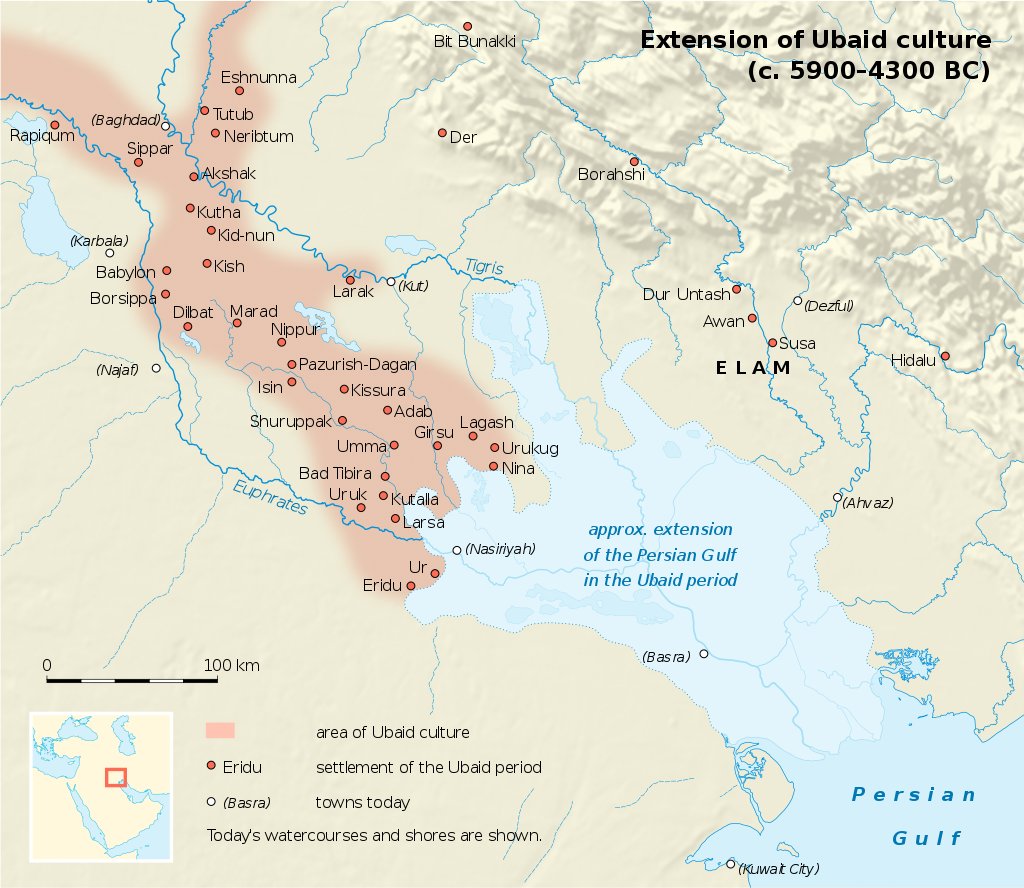
Notable:
- Stamps and Seals
- Stone, hard fired Clay, and Metal Tools
- Hydraulically Irrigated Agriculture
- The Plough
- Sailing Vessels
- Beginning of specialized crafstmen – a division of labor.
- Beginning of Pareto Distribution (social hierarchy or stratification)
- Beginning of “Manors” vs Village Homes
Ubaid culture is characterized by large unwalled village settlements, multi-roomed rectangular mud-brick houses and the appearance of the first temples of public architecture in Mesopotamia, with a growth of a two tier settlement hierarchy of centralized large sites of more than 10 hectares surrounded by smaller village sites of less than 1 hectare.[25] Domestic equipment included a distinctive fine quality buff or greenish colored pottery decorated with geometric designs in brown or black paint. Tools such as sickles were often made of hard fired clay in the south, while in the north stone and sometimes metal were used. Villages thus contained specialised craftspeople, potters, weavers and metalworkers, although the bulk of the population were agricultural labourers, farmers and seasonal pastoralists.
During the Ubaid Period [5000–4000 BC], the movement towards urbanization began. “Agriculture and animal husbandry [domestication] were widely practiced in sedentary communities”.[citation needed] There were also tribes that practiced domesticating animals as far north as Turkey, and as far south as the Zagros Mountains. The Ubaid period in the south was associated with intensive irrigated hydraulic agriculture, and the use of the plough, both introduced from the north, possibly through the earlier Choga Mami, Hadji Muhammed and Samarra cultures.
Spread of Ubaid Culture
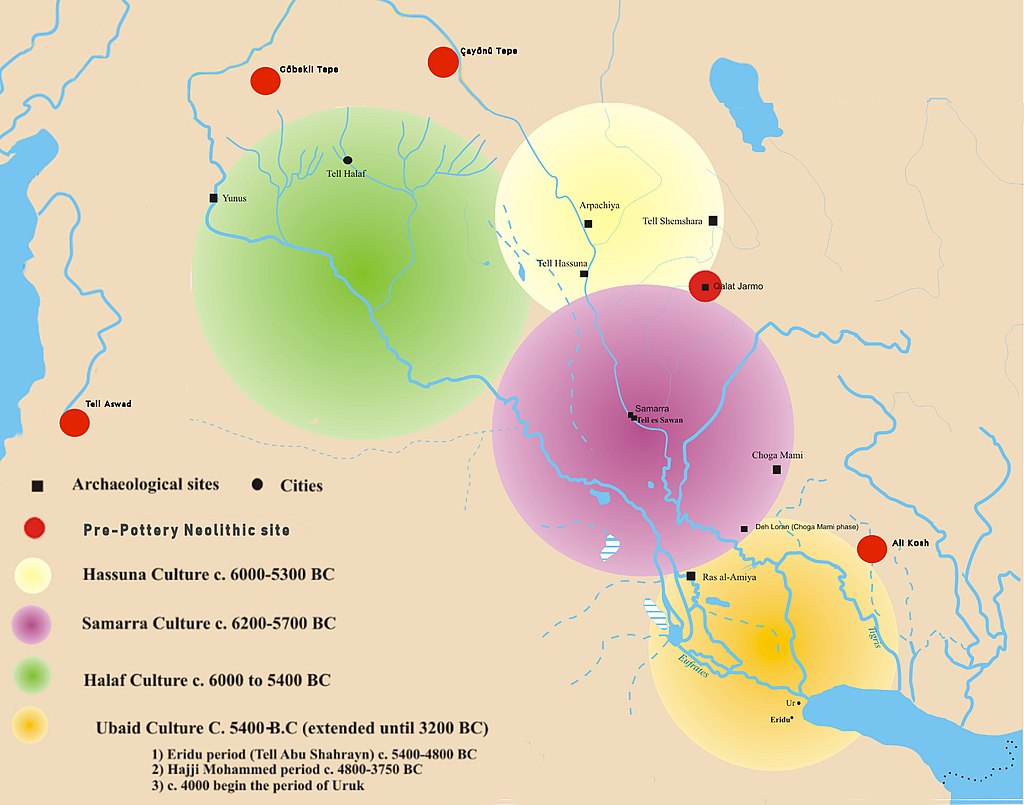
The Sumerian Period (c.?4500 – c.?1900 BC)
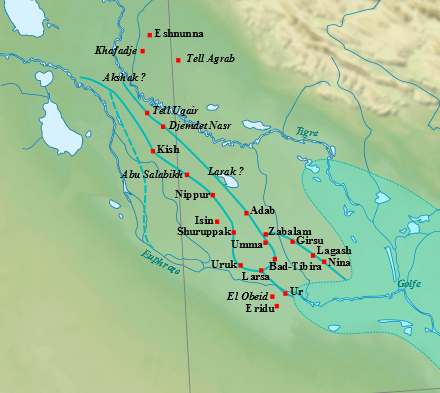
Europe
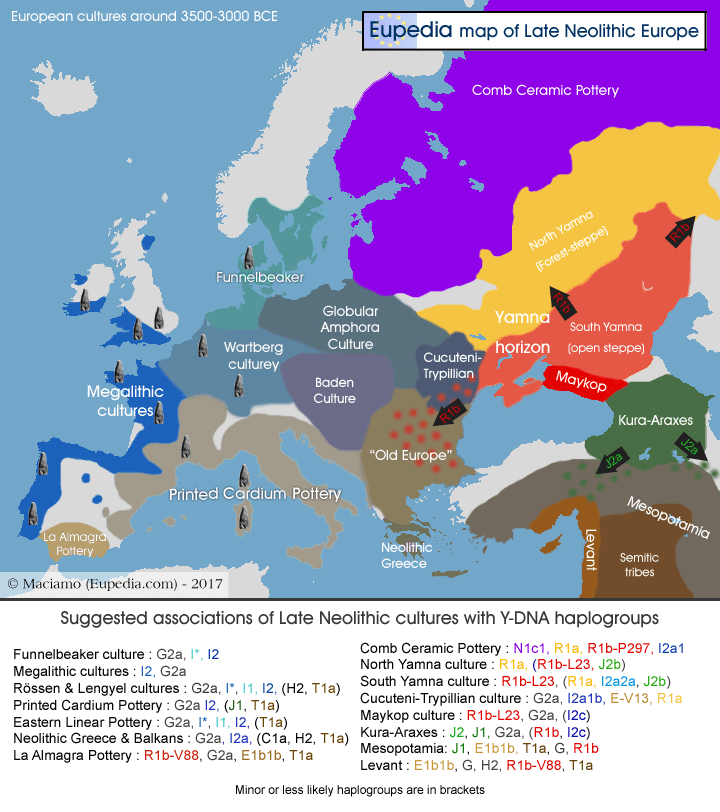
Northeast Europe: Pit-Comb (Comb Ware) Ceramic Culture (4,200 BC – 2,000 BC) in Norway, Sweden, Finland, Poland, and Estonia. (Soultrean > Swiderian > Kundra > Narva > Pit Comb -> Volsovo -> Corded Ware). 65% Eastern Hunter-Gatherer (EHG), 20% Western Steppe Herder (WSH), and 15% Western Hunter-Gatherer (WHG) descent. The amount of EHG ancestry was higher than among earlier cultures of the eastern Baltic, while WSH ancestry had previously never been attested among such an early culture in the region.
The people continued the Mesolithic hunter-gatherer lifestyle, with traces of early agriculture. The settlements were located at sea shores or beside lakes and the economy was based on hunting, fishing and the gathering of plants. In Finland, it was a maritime culture which became more and more specialized in hunting seals. The dominant dwelling was probably a teepee of about 30 square meters where some 15 people could live. Also rectangular houses made of timber become popular in Finland from 4000 BC cal. Graves were dug at the settlements and the dead were covered with red ochre. The typical Comb Ceramic age shows an extensive use of objects made of flint and amber as grave offerings.
The Pit–Comb Ware culture is one of the few exceptions to the rule that pottery and farming coexist in Europe. The ceramics consist of large pots that are rounded or pointed below, with a capacity from 40 to 60 litres. The forms of the vessels remained unchanged but the decoration varied. In the Near East farming appeared before pottery, then when farming spread into Europe from the Near East, pottery-making came with it. However, in Asia, where the oldest pottery has been found, pottery was made long before farming. So, it appears that the Comb Ceramic Culture reflects influences from Siberia and distant China – and by implication, that pottery may have arrived by the northern route not southern.
The North Caucuses (The Gateway to the Steppe)
Maykop Culture (3700BC to 3000BC)
The Maikop population came from the south, probably from western Georgia and Abkhazia, and was descended from the Eneolithic farmers who first colonized the north side of the Caucasus. Maykop is therefore the “ideal archaeological candidate for the founders of the Northwest Caucasian language family”
To the north is the Yamna culture, including the Novotitorovka culture (3300—2700), which it overlaps in territorial extent. It is contemporaneous with the late Uruk period in Mesopotamia.
The settlement is of a typical Western-Asian variety, with the dwellings packed closely together and made of mud bricks with smoke outlets.
The Pontic Steppe (Europe)
Yamna Culture
[ COMPLETE THIS NARRATIVE ]
The Bronze Age
(Historical)
Pre-History > Protohistory >
Ancient History (“Writing”)
[ COMPLETE THIS NARRATIVE ]
(Human – Technological)
Holocene >
Bronze Age (3,000 BC to 1050 BC)
[ COMPLETE THIS NARRATIVE ]
Indus Valley
The Indus Valley (IVC) or Harapan Civilisation was a Bronze Age civilisation in the northwestern regions of South Asia, lasting from 3300 BCE to 1300 BCE, and in its mature form from 2600 BCE to 1900 BCE. Together with ancient Egypt and Mesopotamia, it was one of three early civilisations of the Near East and South Asia, and of the three, the most widespread, its sites spanning an area stretching from northeast Afghanistan, through much of Pakistan, and into western and northwestern India.
urban planning, baked brick houses, elaborate drainage systems, water supply systems, clusters of large non-residential buildings, and new techniques in handicraft (carnelian products, seal carving) and metallurgy (copper, bronze, lead, and tin).[4] The large cities of Mohenjo-daro and Harappa very likely grew to containing between 30,000 and 60,000 individuals,[5][c] and the civilisation itself during its florescence may have contained between one and five million individuals.
Mesopotamia
The Uruk Period
The South Caucuses (Border between South and North Asia)
Wealth Comes to the Caucuses, and Expansion of Influence
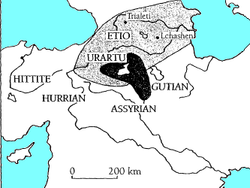
Transcaucasia an the Leyla-Tepe or “Leilatepe” and Kura Araxes Cultures (3000 BC) (Albania-Azerbaijan and the broader trans-caucuses region from east anatolia to northwest iran.
Present theory is that when Uruk Collapsed (the Uruk Collapse) migrants conquered, burned, killed, and replaced existing peoples.
While earlier periods in the region, metal was scarce, this period is the first appearance of local and increasingly sophisticated metallurgy, that we currently attribute to migrants from or trade with Uruk or Pre-Uruk technology in Mesopotamia, beginning about 4500 BCE. a poorly developed social hierarchy for a significant stretch of their history.
Some settlements were surrounded by stone walls. Homes followed period tradition and were built of mud-brick, originally round, but later subrectangular designs with one or two rooms, multiple rooms centered around an open space, or rectilinear (long house) designs. They raised cattle, sheep, goats, dogs, and in later phases, horses. The dead were buried in ceramic vessels (amphora), usually used to store grain.
Note that after 2500 we see evidence of exploitation of mountainous areas (pastoralism), horse bones(horse domestication), kurgan burials (wealth), kurgan burials rich in artifacts including gold and silver jewelry(social hierarchy).
Egypt
A Story Of Rivers and Consequences
A Little More “Geography in Everything”
Europe
The Steppe vs River-forests vs Flood River Valleys
(the beginning of social formation that will lead to institution formation)
China
India
Mesopotamia
Nile
Europe
( … )
The Indo European (Aryan) Expansion: Steppe Hybridization
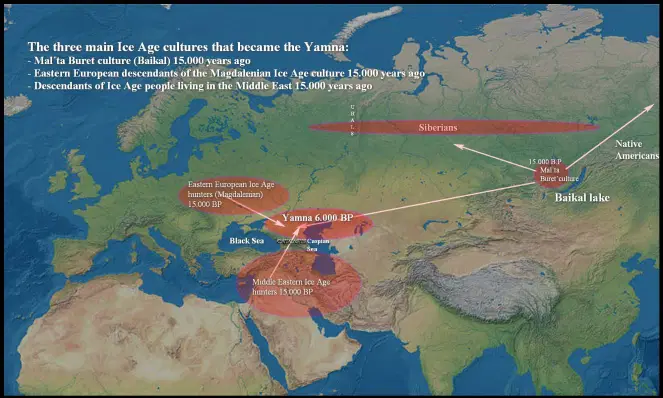
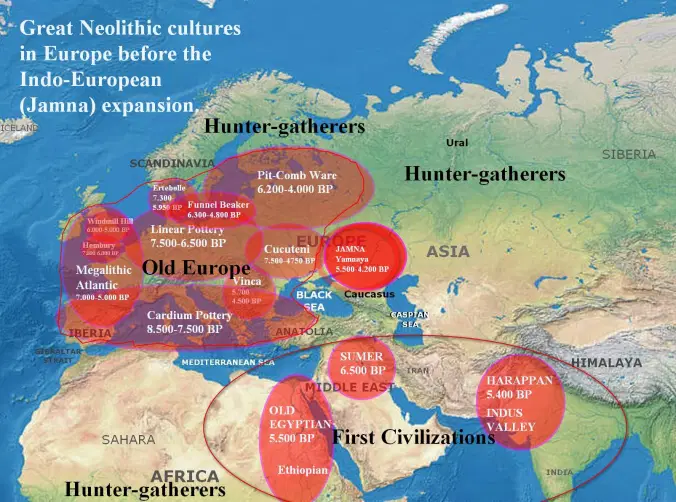
During the Late Neolithic and Early Bronze Age, Western Steppe Herders (WSHs) from the Pontic-Caspian steppe embarked on a massive expansion, which further displaced the WHGs. Among present day populations, WHG ancestry is most common among populations of the eastern Baltic, north of the eurasian plain..
The EEF-derived cultures of Europe were overwhelmed by successive invasions of Western Steppe Herders (WSHs) from the Pontic-Caspian steppe, who were Eastern Hunter-Gatherers (EHG) with possible CHG admixture. These invasions led to EEF Y-DNA in Europe being almost entirely replaced with EHG/WSH Y-DNA (mainly R1b and R1a). EEF mtDNA however remained frequent, suggesting admixture between EHG/WSH males and EEF females. Through subsequent migrations of WSHs into Northern Europe and back into the Eurasian Steppe, EEF mtDNA was brought to new corners of Eurasia.
EHGs carry about 75% Ancient North Eurasian (ANE) descent, and to have contributed significantly to the ancestry of the WHGs and SHGs (who were a mixture of WHG and EHG). During the Neolithic and early Eneolithic, EHGs on the Pontic-Caspian steppe formed the Yamnaya culture, perhaps after some admixture with Caucasus hunter-gatherers (CHGs). The genetic cluster formed from this admixture is known as Western Steppe Herder (WSH). The Yamnaya culture and its descendants are supposed to have embarked on a massive migration leading to the spread of Indo-European languages throughout large parts of Eurasia.
“The Indo-Europeans (I-Es) were highly militarized conquering groups that spread out from the Pontic Steppe region north of the Black Sea to dominate Europe, ending only at the end of the Middle Ages in Western Europe and reverberating even beyond that. What I mean by this is that the social systems that the I-Es put in place had signi?cant commonalities and were fundamentally unchanged over this very long time span.
“Current scholarly opinion is that the I-Es originated in the Pontic Steppe region of southern Russia and Ukraine. In the Near East, Iran, and India, this conquering group was eventually absorbed by the local population, although, for example, there is some indication that the priestly Brahmin caste in India has greater representation of I-E ancestry than other castes in northern India. In Europe, they displaced the native languages but not the natives: Originally, at least, as in the other areas they conquered, they were alien elites ruling over the older Europeans.

Languages
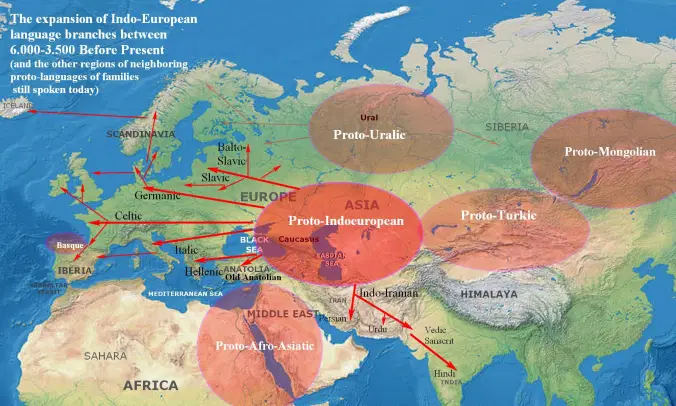
Introgression
Cultures of Early Bronze Age Europe
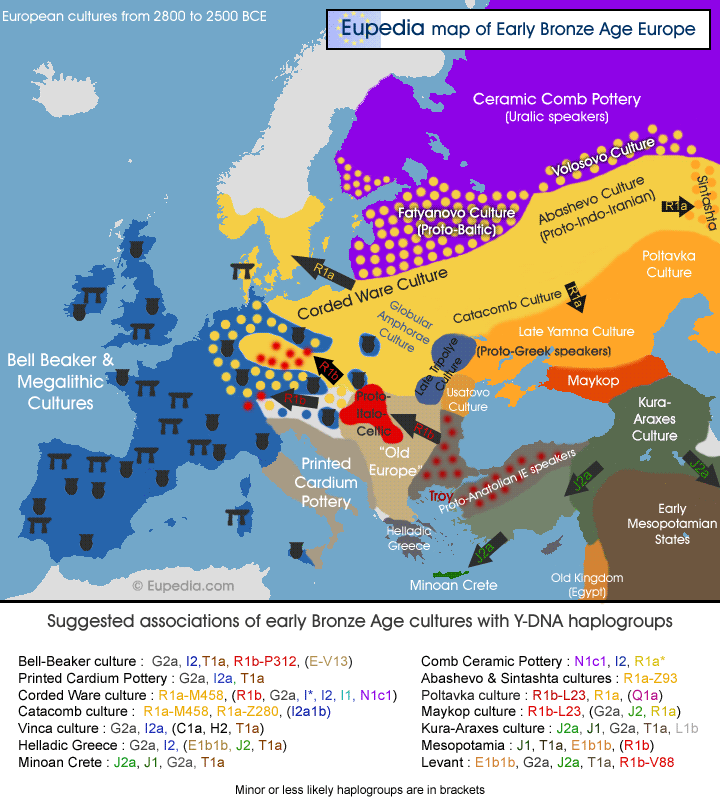
Crisis: The Bronze Age Collapse – The Second Dark Age
(Human) (Technological)
Crisis: The Bronze Age Collapse
( … )
Late Bronze Age Europe – Staging for the Ancient World
(Human) (Conceptual)
Opportunity: The Age of Transformation
(Human) (Technological)
Holocene >
Iron Agethe “Iron Age” begins in any region when the local production of iron or steel has been brought to the point where iron tools and weapons superior to their bronze equivalents become widespread. In the Ancient Near East, this transition takes place in the wake of the so-called Bronze Age collapse, in the 12th century BC. The technology soon spread throughout the Mediterranean Basin region and to South Asia. Its further spread to Central Asia, Eastern Europe, and Central Europe is somewhat delayed, and Northern Europe is reached still later, by about 500 BC.
- For SW Asia, the Ancient Near East, the establishment of the Achaemenid Empire c. 550 BC is usually taken as a cut-off date,
- For Europe, at least Central and Western Europe, the Roman conquests of the 1st century BC serve as marking for the end of the Iron Age. The Germanic Iron Age of Scandinavia is taken to end c. 800 AD, with the beginning of the Viking Age.
- For South Asia (Indian sub-continent), the Iron Age is taken to begin with the ironworking Painted Gray Ware culture in the 18th century BC, and to end with the reign of Ashoka (3rd century BC). The use of the term “Iron Age” in the archaeology of South, East, and Southeast Asia is more recent and less common than for western Eurasia;
- For East Asia, China’s prehistory had ended before iron-working arrived, so the term is infrequently used.
- For Africa, the Sahel (Sudan region) and Sub-Saharan Africa are outside of the three-age system, there being no Bronze Age, but the term “Iron Age” is sometimes used in reference to early cultures practicing ironworking such as the Nok culture of Nigeria.
(Human)
Holocene >
Ancient (Awakening)
Southeastern (Old) Europe: Hellenistic > Roman
Western Europe: Roman > Early Medieval > Medieval > Early Modern > Industrial
Northern Europe: Pre-Roman Age > Roman Iron Age > Germanic Iron Age > Viking > Medieval > Post-Medieval(Early Modern) > Industrial(modern)
(Human)
Holocene >
Medieval (Dark Ages)
Southeastern (Old) Europe: Hellenistic > Roman > Byzantine
Western Europe: Roman > Early Medieval > Medieval
Northern Europe: Pre-Roman Age > Roman Iron Age > Germanic Iron Age > Viking > Medieval
(Human)
Holocene >
Modern (Restoration)
Southeastern (Old) Europe: Hellenistic > Roman > Byzantine > Ottoman
Western Europe: Roman > Early Medieval > Medieval > Early Modern > Industrial
Northern Europe: Pre-Roman Age > Roman Iron Age > Germanic Iron Age > Viking > Medieval > Post-Medieval(Early Modern) > Industrial(modern)

